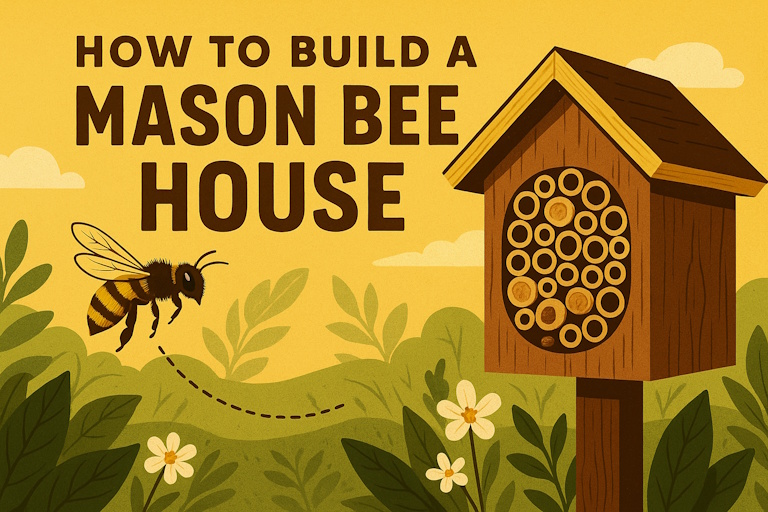🐝 How to Build a Mason Bee House
(…and keep your tiny tenants happy, healthy, and rent‑free)
Mason bees don’t make honey, don’t live in hives, and don’t want drama. They just need dry tubes, spring flowers, and a little clay “mortar” to wall off their nurseries. In return, they’ll supercharge your fruit trees.
🧰 Tools & Materials
-
Untreated wood block (fir, pine, or hardwood). Avoid pressure‑treated and cedar. OSU Extension Service
-
Drill + sharp bits: 3/32″ up to 3/8″; plan to use 5/16″ for blue orchard mason bees (our local star). Depth target ~6″. Xerces Society
-
Paper liners or parchment to roll your own tubes (optional but recommended for cleaning).
-
Mounting screws/bracket (to secure the house 3–6 ft high, facing morning sun).
-
Roof cap (scrap shingle/metal) to shed rain.
-
Clay‑rich mud source (a yogurt tub of clayey mud works).
Local sources (support your neighbors)
-
BRING Recycling (Glenwood): reclaimed wood odds & ends. bringrecycling.org
-
Down To Earth (Eugene): sells bee houses/tubes if you want a kit or backup gear. Down To Earth Home, Garden and Gift downtoearthdistributors.com
-
Lane Forest Products: soils/landscape supplies for that clay corner & native-friendly plantings. laneforest.com
-
Willamette Wildlings (Eugene): native plants & seed for early spring bloom. willamettewildlings.com
-
GloryBee (Eugene): beekeeping supplier with local roots. GloryBee MapQuest
🛡️ Safety First (and Bee First)
-
Wear eye protection when drilling.
-
Do not use pressure‑treated or cedar lumber (chemicals + smell = no thanks).
-
Mount securely; falling houses make cranky bees and sad gardeners.
🔢 Step‑by‑Step Build
1) Cut and plan your block
Aim for a chunky block (e.g., 4×6). Mark a grid so holes end ¾” apart and not too close to edges—prevents splitting and keeps tunnels distinct.
2) Drill clean, dead‑end tunnels
Drill perpendicular to the grain so the inside is smooth. Use 5/16″ diameter for mason bees; depth 5–6″ is ideal (shallower for smaller diameters). Only one open end. If you punch through, screw a backing board on.
Alt: Skip drilling and use cardboard tubes with paper liners ~6″ long, closed at the back. They pull apart for fall cleaning and reduce disease.
3) Add removable liners (highly recommended)
Slide tight‑fitting paper liners into the holes, or roll parchment around a dowel to make your own. Darken the front tips with a marker—helps bees orient.
4) Give it a roof
Screw on a little overhang (scrap shingle or metal) to shed Oregon rain. Nesting cavities must stay dry.
5) Mount in the right microclimate
Hang 3–6 ft high, facing south or southeast for warm morning sun, but shaded later to avoid broiling. Keep it out of wind and rain.
Alt: If you have no weather protection, tuck the house under an eave or in a simple open‑front “birdhouse‑style” box.
6) Place mud bar + flowers = bee bait
Mason bees require moist clay for their “mortar.” Set a small tray of clayey mud nearby and keep one edge damp. Plant or ensure spring bloom (Feb–June): apples, cherries, Oregon grape, dandelion, plus natives. Bees usually forage within 200–300 ft of the nest, so keep resources close.
7) (Optional) Add cocoons in late winter
If natives don’t discover you immediately, place purchased cocoons when daytime highs hit 50–55°F (late Feb–mid‑Mar here). Many houses have an “attic” for safe emergence; otherwise use a small box with a 5/16″ exit hole on top of the tubes.
8) Sit back and watch the mud caps
Females pack pollen, lay an egg, and mud‑cap each cell. Longer tunnels = more female offspring (they put the boys near the front). Another reason 6″ depth matters.
🧼 End‑of‑Season Care (the un‑sexy part that saves bees)
High‑density “bee hotels” must be maintained or they turn into parasite condos. In fall, open liners/blocks, harvest cocoons, and clean:
-
Quick 0.05% bleach dip if mites are present (1 Tbsp bleach in 8 cups water), then rinse & air‑dry.
-
Store cocoons cold (~39°F) with slight humidity over winter; set back out in spring.
If you used solid blocks without liners, sanitize by re‑drilling to loosen debris and soaking in a light bleach solution—or retire the block and replace (“emergence box” method).
Alt (lowest maintenance): Use small bundles (4–6 tunnels each) spread around your yard and replace them often—more “natural density,” less pest buildup.
🧪 Bamboo? Plastic? About those Pinterest pretties…
They look cute, but bamboo & plastic trap moisture and can’t be opened for cleaning—often leading to mold and high losses. Stick with removable cardboard tubes/liners or laminated blocks you can open. OSU Extension Service
🐝 Why bother?
Because mason bees are gentle, wildly efficient early‑season pollinators—perfect for apples, cherries, and pears—and they’ll boost fruit set within a hundred yards of their home.
🛒 Quick Lane County Shopping List
-
Reclaimed wood: BRING Recycling, 4446 Franklin Blvd, Eugene. bringrecycling.org
-
Native plants/seed: Willamette Wildlings (Willamette Valley natives). willamettewildlings.com
-
Soils/mulch: Lane Forest Products (multiple locations/hours). laneforest.com
-
Bee house/tubes: Down To Earth (Eugene) has mason bee houses/education. Down To Earth Home, Garden and Gift
-
General bee supplies: GloryBee (Eugene). GloryBee
💡 Troubleshooting (because things happen)
-
No bees used it: Check sun exposure, move closer to spring flowers, and add a mud tray.
-
Lots of holes but few caps: Tunnels may be too shallow/rough; switch to lined tubes ~6″.
-
Mites/mold: Harvest/clean cocoons; replace or sanitize blocks annually.
🐝 For Those of You Who Like Videos…
🔍 Keyword Phrases
how to build a mason bee house, mason bee house plans Oregon, best hole size for mason bees 5/16, DIY bee hotel with paper liners, where to place mason bee house, mason bee cocoons Oregon spring, mason bee house maintenance and cleaning, clay mud for mason bees, native plants for mason bees Lane County, avoid bamboo bee hotel moisture, OSU Extension mason bee guide, Xerces tunnel nest recommendations, buy mason bee house Eugene, pollinator garden Willamette Valley, Down To Earth mason bee supplies Eugene

